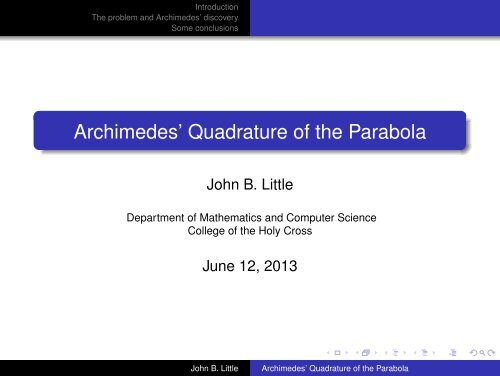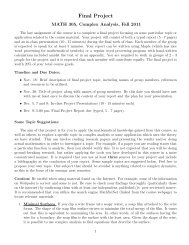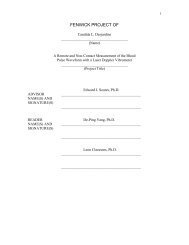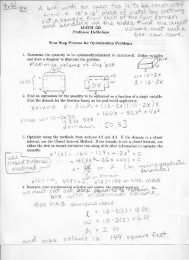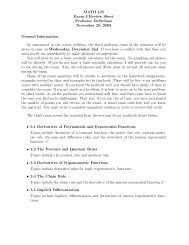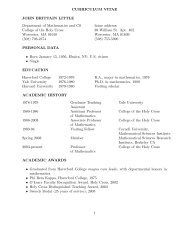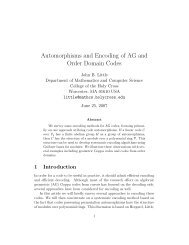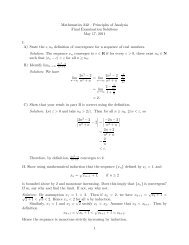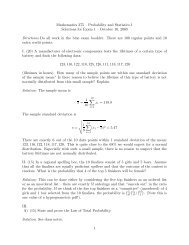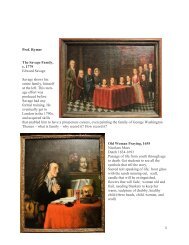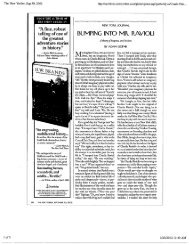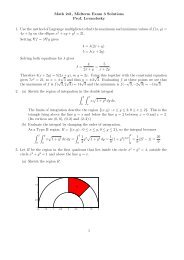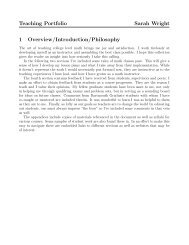Archimedes' Quadrature of the Parabola - Mathematics and ...
Archimedes' Quadrature of the Parabola - Mathematics and ...
Archimedes' Quadrature of the Parabola - Mathematics and ...
Create successful ePaper yourself
Turn your PDF publications into a flip-book with our unique Google optimized e-Paper software.
Introduction<br />
The problem <strong>and</strong> Archimedes’ discovery<br />
Some conclusions<br />
Archimedes’ <strong>Quadrature</strong> <strong>of</strong> <strong>the</strong> <strong>Parabola</strong><br />
John B. Little<br />
Department <strong>of</strong> Ma<strong>the</strong>matics <strong>and</strong> Computer Science<br />
College <strong>of</strong> <strong>the</strong> Holy Cross<br />
June 12, 2013<br />
John B. Little Archimedes’ <strong>Quadrature</strong> <strong>of</strong> <strong>the</strong> <strong>Parabola</strong>
Outline<br />
Introduction<br />
The problem <strong>and</strong> Archimedes’ discovery<br />
Some conclusions<br />
1 Introduction<br />
2 The problem <strong>and</strong> Archimedes’ discovery<br />
3 Some conclusions<br />
John B. Little Archimedes’ <strong>Quadrature</strong> <strong>of</strong> <strong>the</strong> <strong>Parabola</strong>
Introduction<br />
The problem <strong>and</strong> Archimedes’ discovery<br />
Some conclusions<br />
Who was Archimedes?<br />
Lived ca. 287 - 212 BCE, mostly in Greek city <strong>of</strong> Syracuse<br />
in Sicily<br />
John B. Little Archimedes’ <strong>Quadrature</strong> <strong>of</strong> <strong>the</strong> <strong>Parabola</strong>
Introduction<br />
The problem <strong>and</strong> Archimedes’ discovery<br />
Some conclusions<br />
Who was Archimedes?<br />
Lived ca. 287 - 212 BCE, mostly in Greek city <strong>of</strong> Syracuse<br />
in Sicily<br />
Studied many topics in what we would call ma<strong>the</strong>matics,<br />
physics, engineering (less distinction between <strong>the</strong>m at <strong>the</strong><br />
time)<br />
John B. Little Archimedes’ <strong>Quadrature</strong> <strong>of</strong> <strong>the</strong> <strong>Parabola</strong>
Introduction<br />
The problem <strong>and</strong> Archimedes’ discovery<br />
Some conclusions<br />
Who was Archimedes?<br />
Lived ca. 287 - 212 BCE, mostly in Greek city <strong>of</strong> Syracuse<br />
in Sicily<br />
Studied many topics in what we would call ma<strong>the</strong>matics,<br />
physics, engineering (less distinction between <strong>the</strong>m at <strong>the</strong><br />
time)<br />
We don’t know much about his actual life; much <strong>of</strong> his later<br />
reputation was based on somewhat dubious anecdotes,<br />
e.g. <strong>the</strong> “eureka moment,” inventions he was said to have<br />
produced to aid in defense <strong>of</strong> Syracuse during Roman<br />
siege in which he was killed, etc.<br />
John B. Little Archimedes’ <strong>Quadrature</strong> <strong>of</strong> <strong>the</strong> <strong>Parabola</strong>
Introduction<br />
The problem <strong>and</strong> Archimedes’ discovery<br />
Some conclusions<br />
Who was Archimedes?<br />
Lived ca. 287 - 212 BCE, mostly in Greek city <strong>of</strong> Syracuse<br />
in Sicily<br />
Studied many topics in what we would call ma<strong>the</strong>matics,<br />
physics, engineering (less distinction between <strong>the</strong>m at <strong>the</strong><br />
time)<br />
We don’t know much about his actual life; much <strong>of</strong> his later<br />
reputation was based on somewhat dubious anecdotes,<br />
e.g. <strong>the</strong> “eureka moment,” inventions he was said to have<br />
produced to aid in defense <strong>of</strong> Syracuse during Roman<br />
siege in which he was killed, etc.<br />
Perhaps most telling: we do know he designed a<br />
tombstone for himself illustrating <strong>the</strong> discovery he wanted<br />
most to be remembered for (discussed by Plutarch, Cicero)<br />
John B. Little Archimedes’ <strong>Quadrature</strong> <strong>of</strong> <strong>the</strong> <strong>Parabola</strong>
Introduction<br />
The problem <strong>and</strong> Archimedes’ discovery<br />
Some conclusions<br />
Figure: Sphere inscribed in cylinder <strong>of</strong> equal radius<br />
3Vsphere = 2Vcyl <strong>and</strong> Asphere = Acyl (lateral area)<br />
John B. Little Archimedes’ <strong>Quadrature</strong> <strong>of</strong> <strong>the</strong> <strong>Parabola</strong>
Introduction<br />
The problem <strong>and</strong> Archimedes’ discovery<br />
Some conclusions<br />
Surviving works<br />
On <strong>the</strong> Equilibrium <strong>of</strong> Planes (2 books)<br />
John B. Little Archimedes’ <strong>Quadrature</strong> <strong>of</strong> <strong>the</strong> <strong>Parabola</strong>
Introduction<br />
The problem <strong>and</strong> Archimedes’ discovery<br />
Some conclusions<br />
Surviving works<br />
On <strong>the</strong> Equilibrium <strong>of</strong> Planes (2 books)<br />
On Floating Bodies (2 books)<br />
John B. Little Archimedes’ <strong>Quadrature</strong> <strong>of</strong> <strong>the</strong> <strong>Parabola</strong>
Introduction<br />
The problem <strong>and</strong> Archimedes’ discovery<br />
Some conclusions<br />
Surviving works<br />
On <strong>the</strong> Equilibrium <strong>of</strong> Planes (2 books)<br />
On Floating Bodies (2 books)<br />
Measurement <strong>of</strong> a Circle<br />
John B. Little Archimedes’ <strong>Quadrature</strong> <strong>of</strong> <strong>the</strong> <strong>Parabola</strong>
Introduction<br />
The problem <strong>and</strong> Archimedes’ discovery<br />
Some conclusions<br />
Surviving works<br />
On <strong>the</strong> Equilibrium <strong>of</strong> Planes (2 books)<br />
On Floating Bodies (2 books)<br />
Measurement <strong>of</strong> a Circle<br />
On Conoids <strong>and</strong> Spheroids<br />
John B. Little Archimedes’ <strong>Quadrature</strong> <strong>of</strong> <strong>the</strong> <strong>Parabola</strong>
Introduction<br />
The problem <strong>and</strong> Archimedes’ discovery<br />
Some conclusions<br />
Surviving works<br />
On <strong>the</strong> Equilibrium <strong>of</strong> Planes (2 books)<br />
On Floating Bodies (2 books)<br />
Measurement <strong>of</strong> a Circle<br />
On Conoids <strong>and</strong> Spheroids<br />
On Spirals<br />
John B. Little Archimedes’ <strong>Quadrature</strong> <strong>of</strong> <strong>the</strong> <strong>Parabola</strong>
Introduction<br />
The problem <strong>and</strong> Archimedes’ discovery<br />
Some conclusions<br />
Surviving works<br />
On <strong>the</strong> Equilibrium <strong>of</strong> Planes (2 books)<br />
On Floating Bodies (2 books)<br />
Measurement <strong>of</strong> a Circle<br />
On Conoids <strong>and</strong> Spheroids<br />
On Spirals<br />
On <strong>the</strong> Sphere <strong>and</strong> Cylinder (2 books)<br />
John B. Little Archimedes’ <strong>Quadrature</strong> <strong>of</strong> <strong>the</strong> <strong>Parabola</strong>
Introduction<br />
The problem <strong>and</strong> Archimedes’ discovery<br />
Some conclusions<br />
Surviving works, cont.<br />
Book <strong>of</strong> Lemmas, The S<strong>and</strong>-Reckoner, The<br />
Cattle-Problem, <strong>the</strong> Stomachion<br />
John B. Little Archimedes’ <strong>Quadrature</strong> <strong>of</strong> <strong>the</strong> <strong>Parabola</strong>
Introduction<br />
The problem <strong>and</strong> Archimedes’ discovery<br />
Some conclusions<br />
Surviving works, cont.<br />
Book <strong>of</strong> Lemmas, The S<strong>and</strong>-Reckoner, The<br />
Cattle-Problem, <strong>the</strong> Stomachion<br />
<strong>Quadrature</strong> <strong>of</strong> <strong>the</strong> <strong>Parabola</strong><br />
John B. Little Archimedes’ <strong>Quadrature</strong> <strong>of</strong> <strong>the</strong> <strong>Parabola</strong>
Introduction<br />
The problem <strong>and</strong> Archimedes’ discovery<br />
Some conclusions<br />
Surviving works, cont.<br />
Book <strong>of</strong> Lemmas, The S<strong>and</strong>-Reckoner, The<br />
Cattle-Problem, <strong>the</strong> Stomachion<br />
<strong>Quadrature</strong> <strong>of</strong> <strong>the</strong> <strong>Parabola</strong><br />
The Method <strong>of</strong> Mechanical Theorems<br />
John B. Little Archimedes’ <strong>Quadrature</strong> <strong>of</strong> <strong>the</strong> <strong>Parabola</strong>
Introduction<br />
The problem <strong>and</strong> Archimedes’ discovery<br />
Some conclusions<br />
Surviving works, cont.<br />
Book <strong>of</strong> Lemmas, The S<strong>and</strong>-Reckoner, The<br />
Cattle-Problem, <strong>the</strong> Stomachion<br />
<strong>Quadrature</strong> <strong>of</strong> <strong>the</strong> <strong>Parabola</strong><br />
The Method <strong>of</strong> Mechanical Theorems<br />
The Method was long known only from references in o<strong>the</strong>r<br />
works<br />
John B. Little Archimedes’ <strong>Quadrature</strong> <strong>of</strong> <strong>the</strong> <strong>Parabola</strong>
Introduction<br />
The problem <strong>and</strong> Archimedes’ discovery<br />
Some conclusions<br />
Surviving works, cont.<br />
Book <strong>of</strong> Lemmas, The S<strong>and</strong>-Reckoner, The<br />
Cattle-Problem, <strong>the</strong> Stomachion<br />
<strong>Quadrature</strong> <strong>of</strong> <strong>the</strong> <strong>Parabola</strong><br />
The Method <strong>of</strong> Mechanical Theorems<br />
The Method was long known only from references in o<strong>the</strong>r<br />
works<br />
1906 – a palimpsest prayerbook created about 1229 CE (a<br />
reused manuscript) was found by to contain substantial<br />
portions (a 10th century CE copy from older sources)<br />
John B. Little Archimedes’ <strong>Quadrature</strong> <strong>of</strong> <strong>the</strong> <strong>Parabola</strong>
Introduction<br />
The problem <strong>and</strong> Archimedes’ discovery<br />
Some conclusions<br />
A page from <strong>the</strong> palimpsest<br />
John B. Little Archimedes’ <strong>Quadrature</strong> <strong>of</strong> <strong>the</strong> <strong>Parabola</strong>
Introduction<br />
The problem <strong>and</strong> Archimedes’ discovery<br />
Some conclusions<br />
Scientific context<br />
Archimedes flourished at height <strong>of</strong> Hellenistic period;<br />
Greek kingdoms (fragments <strong>of</strong> Alex<strong>and</strong>er’s empire) in<br />
Egypt, Syria, Syracuse strong patrons <strong>of</strong> science <strong>and</strong><br />
ma<strong>the</strong>matics<br />
John B. Little Archimedes’ <strong>Quadrature</strong> <strong>of</strong> <strong>the</strong> <strong>Parabola</strong>
Introduction<br />
The problem <strong>and</strong> Archimedes’ discovery<br />
Some conclusions<br />
Scientific context<br />
Archimedes flourished at height <strong>of</strong> Hellenistic period;<br />
Greek kingdoms (fragments <strong>of</strong> Alex<strong>and</strong>er’s empire) in<br />
Egypt, Syria, Syracuse strong patrons <strong>of</strong> science <strong>and</strong><br />
ma<strong>the</strong>matics<br />
State <strong>of</strong> <strong>the</strong> art in ma<strong>the</strong>matics: 2nd or 3rd generation after<br />
Euclid, rough contemporary <strong>of</strong> Apollonius (best known for<br />
work on conic sections)<br />
John B. Little Archimedes’ <strong>Quadrature</strong> <strong>of</strong> <strong>the</strong> <strong>Parabola</strong>
Introduction<br />
The problem <strong>and</strong> Archimedes’ discovery<br />
Some conclusions<br />
Scientific context<br />
Archimedes flourished at height <strong>of</strong> Hellenistic period;<br />
Greek kingdoms (fragments <strong>of</strong> Alex<strong>and</strong>er’s empire) in<br />
Egypt, Syria, Syracuse strong patrons <strong>of</strong> science <strong>and</strong><br />
ma<strong>the</strong>matics<br />
State <strong>of</strong> <strong>the</strong> art in ma<strong>the</strong>matics: 2nd or 3rd generation after<br />
Euclid, rough contemporary <strong>of</strong> Apollonius (best known for<br />
work on conic sections)<br />
Part <strong>of</strong> an active scientific community in fairly close<br />
communication; for instance several <strong>of</strong> <strong>the</strong> works cited<br />
above start with letters to colleagues<br />
John B. Little Archimedes’ <strong>Quadrature</strong> <strong>of</strong> <strong>the</strong> <strong>Parabola</strong>
Introduction<br />
The problem <strong>and</strong> Archimedes’ discovery<br />
Some conclusions<br />
Scientific context<br />
Archimedes flourished at height <strong>of</strong> Hellenistic period;<br />
Greek kingdoms (fragments <strong>of</strong> Alex<strong>and</strong>er’s empire) in<br />
Egypt, Syria, Syracuse strong patrons <strong>of</strong> science <strong>and</strong><br />
ma<strong>the</strong>matics<br />
State <strong>of</strong> <strong>the</strong> art in ma<strong>the</strong>matics: 2nd or 3rd generation after<br />
Euclid, rough contemporary <strong>of</strong> Apollonius (best known for<br />
work on conic sections)<br />
Part <strong>of</strong> an active scientific community in fairly close<br />
communication; for instance several <strong>of</strong> <strong>the</strong> works cited<br />
above start with letters to colleagues<br />
Example: Letter to Eratos<strong>the</strong>nes (in Alex<strong>and</strong>ria) at start <strong>of</strong><br />
The Method<br />
John B. Little Archimedes’ <strong>Quadrature</strong> <strong>of</strong> <strong>the</strong> <strong>Parabola</strong>
Introduction<br />
The problem <strong>and</strong> Archimedes’ discovery<br />
Some conclusions<br />
Goals for this talk<br />
Discuss a problem treated by Archimedes in The Method<br />
<strong>and</strong> (later?) in <strong>Quadrature</strong> <strong>of</strong> <strong>the</strong> <strong>Parabola</strong> <strong>and</strong> <strong>the</strong> two<br />
different solutions Archimedes gave<br />
John B. Little Archimedes’ <strong>Quadrature</strong> <strong>of</strong> <strong>the</strong> <strong>Parabola</strong>
Introduction<br />
The problem <strong>and</strong> Archimedes’ discovery<br />
Some conclusions<br />
Goals for this talk<br />
Discuss a problem treated by Archimedes in The Method<br />
<strong>and</strong> (later?) in <strong>Quadrature</strong> <strong>of</strong> <strong>the</strong> <strong>Parabola</strong> <strong>and</strong> <strong>the</strong> two<br />
different solutions Archimedes gave<br />
Think about <strong>the</strong> relation <strong>of</strong> <strong>the</strong> methods Archimedes<br />
developed <strong>and</strong> later innovations in ma<strong>the</strong>matics such as<br />
limits, integral calculus, etc.<br />
John B. Little Archimedes’ <strong>Quadrature</strong> <strong>of</strong> <strong>the</strong> <strong>Parabola</strong>
Introduction<br />
The problem <strong>and</strong> Archimedes’ discovery<br />
Some conclusions<br />
Goals for this talk<br />
Discuss a problem treated by Archimedes in The Method<br />
<strong>and</strong> (later?) in <strong>Quadrature</strong> <strong>of</strong> <strong>the</strong> <strong>Parabola</strong> <strong>and</strong> <strong>the</strong> two<br />
different solutions Archimedes gave<br />
Think about <strong>the</strong> relation <strong>of</strong> <strong>the</strong> methods Archimedes<br />
developed <strong>and</strong> later innovations in ma<strong>the</strong>matics such as<br />
limits, integral calculus, etc.<br />
Get a glimpse <strong>of</strong> <strong>the</strong> way Archimedes thought about what<br />
he was doing<br />
John B. Little Archimedes’ <strong>Quadrature</strong> <strong>of</strong> <strong>the</strong> <strong>Parabola</strong>
Introduction<br />
The problem <strong>and</strong> Archimedes’ discovery<br />
Some conclusions<br />
What is <strong>the</strong> area <strong>of</strong> a parabolic segment?<br />
John B. Little Archimedes’ <strong>Quadrature</strong> <strong>of</strong> <strong>the</strong> <strong>Parabola</strong>
Introduction<br />
The problem <strong>and</strong> Archimedes’ discovery<br />
Some conclusions<br />
What is <strong>the</strong> area <strong>of</strong> a parabolic segment?<br />
John B. Little Archimedes’ <strong>Quadrature</strong> <strong>of</strong> <strong>the</strong> <strong>Parabola</strong>
Introduction<br />
The problem <strong>and</strong> Archimedes’ discovery<br />
Some conclusions<br />
What is <strong>the</strong> area <strong>of</strong> a parabolic segment?<br />
Let C have same x-coordinate as <strong>the</strong> midpoint <strong>of</strong> AB<br />
John B. Little Archimedes’ <strong>Quadrature</strong> <strong>of</strong> <strong>the</strong> <strong>Parabola</strong>
Introduction<br />
The problem <strong>and</strong> Archimedes’ discovery<br />
Some conclusions<br />
What is <strong>the</strong> area <strong>of</strong> a parabolic segment?<br />
Let C have same x-coordinate as <strong>the</strong> midpoint <strong>of</strong> AB<br />
The area <strong>of</strong> <strong>the</strong> parabolic segment = 4<br />
3 area(∆ABC)<br />
John B. Little Archimedes’ <strong>Quadrature</strong> <strong>of</strong> <strong>the</strong> <strong>Parabola</strong>
Introduction<br />
The problem <strong>and</strong> Archimedes’ discovery<br />
Some conclusions<br />
“<strong>Quadrature</strong> <strong>of</strong> <strong>the</strong> <strong>Parabola</strong>”<br />
In <strong>the</strong> work in <strong>the</strong> title <strong>of</strong> this slide, Archimedes gives two<br />
different arguments for this statement,<br />
John B. Little Archimedes’ <strong>Quadrature</strong> <strong>of</strong> <strong>the</strong> <strong>Parabola</strong>
Introduction<br />
The problem <strong>and</strong> Archimedes’ discovery<br />
Some conclusions<br />
“<strong>Quadrature</strong> <strong>of</strong> <strong>the</strong> <strong>Parabola</strong>”<br />
In <strong>the</strong> work in <strong>the</strong> title <strong>of</strong> this slide, Archimedes gives two<br />
different arguments for this statement,<br />
One using <strong>the</strong> “method <strong>of</strong> exhaustion” – part <strong>of</strong> st<strong>and</strong>ard<br />
repertoire <strong>of</strong> Euclidean ma<strong>the</strong>matics (see Book 12 <strong>of</strong><br />
Elements), based on work <strong>of</strong> Eudoxus<br />
John B. Little Archimedes’ <strong>Quadrature</strong> <strong>of</strong> <strong>the</strong> <strong>Parabola</strong>
Introduction<br />
The problem <strong>and</strong> Archimedes’ discovery<br />
Some conclusions<br />
“<strong>Quadrature</strong> <strong>of</strong> <strong>the</strong> <strong>Parabola</strong>”<br />
In <strong>the</strong> work in <strong>the</strong> title <strong>of</strong> this slide, Archimedes gives two<br />
different arguments for this statement,<br />
One using <strong>the</strong> “method <strong>of</strong> exhaustion” – part <strong>of</strong> st<strong>and</strong>ard<br />
repertoire <strong>of</strong> Euclidean ma<strong>the</strong>matics (see Book 12 <strong>of</strong><br />
Elements), based on work <strong>of</strong> Eudoxus<br />
A recurring <strong>the</strong>me in his ma<strong>the</strong>matical work (used it as a<br />
st<strong>and</strong>ard method to obtain areas <strong>and</strong> volumes,<br />
approximate <strong>the</strong> value <strong>of</strong> π, etc.)<br />
John B. Little Archimedes’ <strong>Quadrature</strong> <strong>of</strong> <strong>the</strong> <strong>Parabola</strong>
Introduction<br />
The problem <strong>and</strong> Archimedes’ discovery<br />
Some conclusions<br />
“<strong>Quadrature</strong> <strong>of</strong> <strong>the</strong> <strong>Parabola</strong>”<br />
In <strong>the</strong> work in <strong>the</strong> title <strong>of</strong> this slide, Archimedes gives two<br />
different arguments for this statement,<br />
One using <strong>the</strong> “method <strong>of</strong> exhaustion” – part <strong>of</strong> st<strong>and</strong>ard<br />
repertoire <strong>of</strong> Euclidean ma<strong>the</strong>matics (see Book 12 <strong>of</strong><br />
Elements), based on work <strong>of</strong> Eudoxus<br />
A recurring <strong>the</strong>me in his ma<strong>the</strong>matical work (used it as a<br />
st<strong>and</strong>ard method to obtain areas <strong>and</strong> volumes,<br />
approximate <strong>the</strong> value <strong>of</strong> π, etc.)<br />
One by <strong>the</strong> novel method also described in The Method<br />
John B. Little Archimedes’ <strong>Quadrature</strong> <strong>of</strong> <strong>the</strong> <strong>Parabola</strong>
Introduction<br />
The problem <strong>and</strong> Archimedes’ discovery<br />
Some conclusions<br />
“<strong>Quadrature</strong> <strong>of</strong> <strong>the</strong> <strong>Parabola</strong>”<br />
In <strong>the</strong> work in <strong>the</strong> title <strong>of</strong> this slide, Archimedes gives two<br />
different arguments for this statement,<br />
One using <strong>the</strong> “method <strong>of</strong> exhaustion” – part <strong>of</strong> st<strong>and</strong>ard<br />
repertoire <strong>of</strong> Euclidean ma<strong>the</strong>matics (see Book 12 <strong>of</strong><br />
Elements), based on work <strong>of</strong> Eudoxus<br />
A recurring <strong>the</strong>me in his ma<strong>the</strong>matical work (used it as a<br />
st<strong>and</strong>ard method to obtain areas <strong>and</strong> volumes,<br />
approximate <strong>the</strong> value <strong>of</strong> π, etc.)<br />
One by <strong>the</strong> novel method also described in The Method<br />
We will look at both <strong>of</strong> <strong>the</strong>se using modern notation – both<br />
quite interesting!<br />
John B. Little Archimedes’ <strong>Quadrature</strong> <strong>of</strong> <strong>the</strong> <strong>Parabola</strong>
Introduction<br />
The problem <strong>and</strong> Archimedes’ discovery<br />
Some conclusions<br />
What’s special about this C?<br />
Can show easily with calculus (<strong>and</strong> less so using <strong>the</strong><br />
geometric definition <strong>of</strong> a parabola): The tangent to <strong>the</strong><br />
parabola at C is parallel to AB<br />
John B. Little Archimedes’ <strong>Quadrature</strong> <strong>of</strong> <strong>the</strong> <strong>Parabola</strong>
Introduction<br />
The problem <strong>and</strong> Archimedes’ discovery<br />
Some conclusions<br />
What’s special about this C?<br />
Can show easily with calculus (<strong>and</strong> less so using <strong>the</strong><br />
geometric definition <strong>of</strong> a parabola): The tangent to <strong>the</strong><br />
parabola at C is parallel to AB<br />
So for this C, <strong>and</strong> this C only, <strong>the</strong> heights <strong>of</strong> <strong>the</strong> triangle<br />
<strong>and</strong> <strong>the</strong> parabolic segment are equal<br />
John B. Little Archimedes’ <strong>Quadrature</strong> <strong>of</strong> <strong>the</strong> <strong>Parabola</strong>
Introduction<br />
The problem <strong>and</strong> Archimedes’ discovery<br />
Some conclusions<br />
What’s special about this C?<br />
Can show easily with calculus (<strong>and</strong> less so using <strong>the</strong><br />
geometric definition <strong>of</strong> a parabola): The tangent to <strong>the</strong><br />
parabola at C is parallel to AB<br />
So for this C, <strong>and</strong> this C only, <strong>the</strong> heights <strong>of</strong> <strong>the</strong> triangle<br />
<strong>and</strong> <strong>the</strong> parabolic segment are equal<br />
The point C is called <strong>the</strong> vertex <strong>of</strong> <strong>the</strong> segment<br />
John B. Little Archimedes’ <strong>Quadrature</strong> <strong>of</strong> <strong>the</strong> <strong>Parabola</strong>
Introduction<br />
The problem <strong>and</strong> Archimedes’ discovery<br />
Some conclusions<br />
Sketch <strong>of</strong> Archimedes’ first pro<strong>of</strong><br />
Now have two smaller parabolic segments; let <strong>the</strong>ir vertices<br />
be C1 <strong>and</strong> C2 <strong>and</strong> construct triangles ∆AC1C <strong>and</strong> ∆CC2B<br />
John B. Little Archimedes’ <strong>Quadrature</strong> <strong>of</strong> <strong>the</strong> <strong>Parabola</strong>
Introduction<br />
The problem <strong>and</strong> Archimedes’ discovery<br />
Some conclusions<br />
Sketch <strong>of</strong> Archimedes’ first pro<strong>of</strong><br />
Now have two smaller parabolic segments; let <strong>the</strong>ir vertices<br />
be C1 <strong>and</strong> C2 <strong>and</strong> construct triangles ∆AC1C <strong>and</strong> ∆CC2B<br />
John B. Little Archimedes’ <strong>Quadrature</strong> <strong>of</strong> <strong>the</strong> <strong>Parabola</strong>
Introduction<br />
The problem <strong>and</strong> Archimedes’ discovery<br />
Some conclusions<br />
The first pro<strong>of</strong>, continued<br />
Archimedes shows that each <strong>of</strong> those triangles has area 1<br />
8<br />
<strong>the</strong> area <strong>of</strong> ∆ABC, so<br />
area(∆AC1C) + area(∆CC2B) = 1<br />
4 area(∆ABC).<br />
John B. Little Archimedes’ <strong>Quadrature</strong> <strong>of</strong> <strong>the</strong> <strong>Parabola</strong>
Introduction<br />
The problem <strong>and</strong> Archimedes’ discovery<br />
Some conclusions<br />
The first pro<strong>of</strong>, continued<br />
Archimedes shows that each <strong>of</strong> those triangles has area 1<br />
8<br />
<strong>the</strong> area <strong>of</strong> ∆ABC, so<br />
area(∆AC1C) + area(∆CC2B) = 1<br />
4 area(∆ABC).<br />
We do this construction some finite number n <strong>of</strong> times <strong>and</strong><br />
add toge<strong>the</strong>r <strong>the</strong> areas <strong>of</strong> all <strong>the</strong> triangles,<br />
John B. Little Archimedes’ <strong>Quadrature</strong> <strong>of</strong> <strong>the</strong> <strong>Parabola</strong>
Introduction<br />
The problem <strong>and</strong> Archimedes’ discovery<br />
Some conclusions<br />
First pro<strong>of</strong>, continued<br />
letting A0 be <strong>the</strong> original area, A1 = 1<br />
4A0 <strong>the</strong> area <strong>of</strong> <strong>the</strong><br />
first two smaller triangles, <strong>the</strong>n A2 = 1<br />
4A1 = 1<br />
42 A0 <strong>the</strong> area<br />
<strong>of</strong> <strong>the</strong> next four, etc.<br />
John B. Little Archimedes’ <strong>Quadrature</strong> <strong>of</strong> <strong>the</strong> <strong>Parabola</strong>
Introduction<br />
The problem <strong>and</strong> Archimedes’ discovery<br />
Some conclusions<br />
First pro<strong>of</strong>, continued<br />
letting A0 be <strong>the</strong> original area, A1 = 1<br />
4A0 <strong>the</strong> area <strong>of</strong> <strong>the</strong><br />
first two smaller triangles, <strong>the</strong>n A2 = 1<br />
4A1 = 1<br />
42 A0 <strong>the</strong> area<br />
<strong>of</strong> <strong>the</strong> next four, etc.<br />
we have total area<br />
Sn = A0 + 1<br />
4 A0 + 1<br />
42 A0 + · · · + 1<br />
4<br />
n A0<br />
John B. Little Archimedes’ <strong>Quadrature</strong> <strong>of</strong> <strong>the</strong> <strong>Parabola</strong>
Introduction<br />
The problem <strong>and</strong> Archimedes’ discovery<br />
Some conclusions<br />
First pro<strong>of</strong>, continued<br />
letting A0 be <strong>the</strong> original area, A1 = 1<br />
4A0 <strong>the</strong> area <strong>of</strong> <strong>the</strong><br />
first two smaller triangles, <strong>the</strong>n A2 = 1<br />
4A1 = 1<br />
42 A0 <strong>the</strong> area<br />
<strong>of</strong> <strong>the</strong> next four, etc.<br />
we have total area<br />
Sn = A0 + 1<br />
4 A0 + 1<br />
42 A0 + · · · + 1<br />
4<br />
n A0<br />
Moreover, 4<br />
3 A0 − Sn = 1<br />
3 An, so as n increases without<br />
bound, Sn tends to 4<br />
3 A0<br />
John B. Little Archimedes’ <strong>Quadrature</strong> <strong>of</strong> <strong>the</strong> <strong>Parabola</strong>
Introduction<br />
The problem <strong>and</strong> Archimedes’ discovery<br />
Some conclusions<br />
First pro<strong>of</strong>, concluded<br />
On <strong>the</strong> o<strong>the</strong>r h<strong>and</strong>, as n increases without bound, <strong>the</strong><br />
triangles constructed above fill out all <strong>of</strong> <strong>the</strong> area in <strong>the</strong><br />
parabolic segment, so<br />
John B. Little Archimedes’ <strong>Quadrature</strong> <strong>of</strong> <strong>the</strong> <strong>Parabola</strong>
Introduction<br />
The problem <strong>and</strong> Archimedes’ discovery<br />
Some conclusions<br />
First pro<strong>of</strong>, concluded<br />
On <strong>the</strong> o<strong>the</strong>r h<strong>and</strong>, as n increases without bound, <strong>the</strong><br />
triangles constructed above fill out all <strong>of</strong> <strong>the</strong> area in <strong>the</strong><br />
parabolic segment, so<br />
Archimedes concludes that <strong>the</strong> area <strong>of</strong> <strong>the</strong> parabolic<br />
segment = 4 area(∆ABC) as claimed before.<br />
3A0 = 4<br />
3<br />
John B. Little Archimedes’ <strong>Quadrature</strong> <strong>of</strong> <strong>the</strong> <strong>Parabola</strong>
Introduction<br />
The problem <strong>and</strong> Archimedes’ discovery<br />
Some conclusions<br />
First pro<strong>of</strong>, concluded<br />
On <strong>the</strong> o<strong>the</strong>r h<strong>and</strong>, as n increases without bound, <strong>the</strong><br />
triangles constructed above fill out all <strong>of</strong> <strong>the</strong> area in <strong>the</strong><br />
parabolic segment, so<br />
Archimedes concludes that <strong>the</strong> area <strong>of</strong> <strong>the</strong> parabolic<br />
segment = 4 area(∆ABC) as claimed before.<br />
3A0 = 4<br />
3<br />
We would derive all this, <strong>of</strong> course, using <strong>the</strong> usual<br />
properties <strong>of</strong> finite <strong>and</strong> infinite geometric series:<br />
area <strong>of</strong> segment =<br />
∞<br />
n=0<br />
A0<br />
4<br />
n = A0<br />
1 − 1<br />
4<br />
= 4A0<br />
3 .<br />
Archimedes had to do it all in an ad hoc way because that<br />
general <strong>the</strong>ory did not exist yet!<br />
John B. Little Archimedes’ <strong>Quadrature</strong> <strong>of</strong> <strong>the</strong> <strong>Parabola</strong>
Introduction<br />
The problem <strong>and</strong> Archimedes’ discovery<br />
Some conclusions<br />
Archimedes’ second pro<strong>of</strong><br />
Now, <strong>the</strong> remarkable second pro<strong>of</strong> that Archimedes<br />
presents both in <strong>Quadrature</strong> <strong>of</strong> <strong>the</strong> <strong>Parabola</strong> <strong>and</strong> in The<br />
Method<br />
John B. Little Archimedes’ <strong>Quadrature</strong> <strong>of</strong> <strong>the</strong> <strong>Parabola</strong>
Introduction<br />
The problem <strong>and</strong> Archimedes’ discovery<br />
Some conclusions<br />
Archimedes’ second pro<strong>of</strong><br />
Now, <strong>the</strong> remarkable second pro<strong>of</strong> that Archimedes<br />
presents both in <strong>Quadrature</strong> <strong>of</strong> <strong>the</strong> <strong>Parabola</strong> <strong>and</strong> in The<br />
Method<br />
We’ll follow <strong>the</strong> presentation in The Method (in Heath’s<br />
translation) – this seems (to me) to be a less polished form<br />
<strong>of</strong> <strong>the</strong> argument <strong>and</strong> even more instructive about what<br />
Archimedes was getting at<br />
John B. Little Archimedes’ <strong>Quadrature</strong> <strong>of</strong> <strong>the</strong> <strong>Parabola</strong>
Introduction<br />
The problem <strong>and</strong> Archimedes’ discovery<br />
Some conclusions<br />
Archimedes’ second pro<strong>of</strong><br />
Now, <strong>the</strong> remarkable second pro<strong>of</strong> that Archimedes<br />
presents both in <strong>Quadrature</strong> <strong>of</strong> <strong>the</strong> <strong>Parabola</strong> <strong>and</strong> in The<br />
Method<br />
We’ll follow <strong>the</strong> presentation in The Method (in Heath’s<br />
translation) – this seems (to me) to be a less polished form<br />
<strong>of</strong> <strong>the</strong> argument <strong>and</strong> even more instructive about what<br />
Archimedes was getting at<br />
Key Idea: Apply a physical analogy – will compute <strong>the</strong> area<br />
<strong>of</strong> <strong>the</strong> parabolic segment essentially by considering it as a<br />
thin plate, or “lamina,” <strong>of</strong> constant density <strong>and</strong> “weighing it<br />
on a balance” in an extremely clever way<br />
John B. Little Archimedes’ <strong>Quadrature</strong> <strong>of</strong> <strong>the</strong> <strong>Parabola</strong>
Introduction<br />
The problem <strong>and</strong> Archimedes’ discovery<br />
Some conclusions<br />
The construction<br />
Note: ∆ in figure = D in<br />
text (a Maple issue!)<br />
CF is tangent to <strong>the</strong><br />
parabola at C<br />
B is <strong>the</strong> vertex<br />
O is an arbitrary point<br />
along <strong>the</strong> line from A to C<br />
ED, MO, FA are parallel to<br />
<strong>the</strong> axis <strong>of</strong> <strong>the</strong> parabola<br />
John B. Little Archimedes’ <strong>Quadrature</strong> <strong>of</strong> <strong>the</strong> <strong>Parabola</strong>
Introduction<br />
The problem <strong>and</strong> Archimedes’ discovery<br />
Some conclusions<br />
First observation<br />
By construction <strong>of</strong> <strong>the</strong><br />
vertex B, area(∆ADB) =<br />
area(∆CDB)<br />
“Well-known” property <strong>of</strong><br />
parabolas (at least in<br />
Archimedes’ time!):<br />
BE = BD, NM = NO,<br />
KA = KF<br />
∴ area(∆EDC) =<br />
area(∆ABC) <strong>and</strong> by<br />
similar triangles,<br />
area(∆AFC) = 4·area(ABC)<br />
John B. Little Archimedes’ <strong>Quadrature</strong> <strong>of</strong> <strong>the</strong> <strong>Parabola</strong>
Next steps<br />
Introduction<br />
The problem <strong>and</strong> Archimedes’ discovery<br />
Some conclusions<br />
Produce CK to H making<br />
CK = KH<br />
Consider CH “as <strong>the</strong> bar <strong>of</strong><br />
a balance” with K at<br />
fulcrum<br />
Known facts about<br />
triangles (proved by<br />
Archimedes earlier): The<br />
centroid <strong>of</strong> ∆AFC is<br />
located at a point W along<br />
CK with CK = 3 · KW .<br />
John B. Little Archimedes’ <strong>Quadrature</strong> <strong>of</strong> <strong>the</strong> <strong>Parabola</strong>
Introduction<br />
The problem <strong>and</strong> Archimedes’ discovery<br />
Some conclusions<br />
“Dissection” step<br />
Consider PO (think <strong>of</strong> a<br />
thin strip approximating <strong>the</strong><br />
part <strong>of</strong> <strong>the</strong> parabolic<br />
segment with some<br />
thickness ∆x)<br />
Properties <strong>of</strong> parabolas<br />
<strong>and</strong> similar triangles imply<br />
MO : PO = AC : AO =<br />
CK : KN = HK : KN<br />
Place segment TG = PO<br />
with midpoint at H.<br />
Then Archimedes’ law <strong>of</strong><br />
<strong>the</strong> lever (fulcrum at K )<br />
says TG balances MO<br />
John B. Little Archimedes’ <strong>Quadrature</strong> <strong>of</strong> <strong>the</strong> <strong>Parabola</strong>
Introduction<br />
The problem <strong>and</strong> Archimedes’ discovery<br />
Some conclusions<br />
Conclusion <strong>of</strong> <strong>the</strong> pro<strong>of</strong><br />
Do this for all “strips” like<br />
PO. We get that ∆ACF<br />
exactly balances <strong>the</strong> whole<br />
collection <strong>of</strong> vertical strips<br />
making up <strong>the</strong> parabolic<br />
segment.<br />
By <strong>the</strong> law <strong>of</strong> <strong>the</strong> lever<br />
again, area(∆ACF) :<br />
area <strong>of</strong> segment = HK :<br />
KW = 3 : 1<br />
Since area(∆ACF) =<br />
4 · area(∆ABC), <strong>the</strong> pro<strong>of</strong><br />
is complete.<br />
John B. Little Archimedes’ <strong>Quadrature</strong> <strong>of</strong> <strong>the</strong> <strong>Parabola</strong>
Introduction<br />
The problem <strong>and</strong> Archimedes’ discovery<br />
Some conclusions<br />
From <strong>the</strong> introductory letter <strong>of</strong> The Method to Eratos<strong>the</strong>nes<br />
“Seeing moreover in you, as I say, an earnest student, a man <strong>of</strong><br />
considerable eminence in philosophy, <strong>and</strong> an admirer <strong>of</strong><br />
ma<strong>the</strong>matical inquiry, I thought fit to write out for you <strong>and</strong><br />
explain in detail ... a certain method by which it will be possible<br />
for you to get a start to enable you to investigate some <strong>of</strong> <strong>the</strong><br />
problems in ma<strong>the</strong>matics by means <strong>of</strong> mechanics. This<br />
procedure is, I am persuaded, no less useful even for <strong>the</strong> pro<strong>of</strong><br />
<strong>of</strong> <strong>the</strong> <strong>the</strong>orems <strong>the</strong>mselves; for certain things first became<br />
clear to me by a mechanical method, although <strong>the</strong>y had to be<br />
demonstrated by geometry afterwards because <strong>the</strong>ir<br />
investigation by <strong>the</strong> said method did not furnish an actual<br />
demonstration.”<br />
Translation by T.L. Heath<br />
John B. Little Archimedes’ <strong>Quadrature</strong> <strong>of</strong> <strong>the</strong> <strong>Parabola</strong>
Introduction<br />
The problem <strong>and</strong> Archimedes’ discovery<br />
Some conclusions<br />
What does this tell us?<br />
Can certainly say that Archimedes anticipated many ideas<br />
<strong>of</strong> integral calculus in this work<br />
John B. Little Archimedes’ <strong>Quadrature</strong> <strong>of</strong> <strong>the</strong> <strong>Parabola</strong>
Introduction<br />
The problem <strong>and</strong> Archimedes’ discovery<br />
Some conclusions<br />
What does this tell us?<br />
Can certainly say that Archimedes anticipated many ideas<br />
<strong>of</strong> integral calculus in this work<br />
But he was also careful <strong>and</strong> realized that he didn’t have a<br />
complete justification for <strong>the</strong> idea <strong>of</strong> “balancing” an area<br />
with a collection <strong>of</strong> line segments<br />
John B. Little Archimedes’ <strong>Quadrature</strong> <strong>of</strong> <strong>the</strong> <strong>Parabola</strong>
Introduction<br />
The problem <strong>and</strong> Archimedes’ discovery<br />
Some conclusions<br />
What does this tell us?<br />
Can certainly say that Archimedes anticipated many ideas<br />
<strong>of</strong> integral calculus in this work<br />
But he was also careful <strong>and</strong> realized that he didn’t have a<br />
complete justification for <strong>the</strong> idea <strong>of</strong> “balancing” an area<br />
with a collection <strong>of</strong> line segments<br />
So he also worked out <strong>the</strong> first “method <strong>of</strong> exhaustion”<br />
pro<strong>of</strong> to supply an argument that would satisfy <strong>the</strong><br />
ma<strong>the</strong>maticians <strong>of</strong> his day<br />
John B. Little Archimedes’ <strong>Quadrature</strong> <strong>of</strong> <strong>the</strong> <strong>Parabola</strong>
Introduction<br />
The problem <strong>and</strong> Archimedes’ discovery<br />
Some conclusions<br />
Recognized in antiquity as a master<br />
“In weightiness <strong>of</strong> matter <strong>and</strong> elegance <strong>of</strong> style, no classical<br />
ma<strong>the</strong>matics treatise surpasses <strong>the</strong> works <strong>of</strong> Archimedes. This<br />
was recognized in antiquity; thus Plutarch says <strong>of</strong> Archimedes’<br />
works:<br />
‘It is not possible to find in all geometry more difficult <strong>and</strong><br />
intricate questions, or more simple <strong>and</strong> lucid explanations.<br />
Some ascribe this to his genius; while o<strong>the</strong>rs think that<br />
incredible effort <strong>and</strong> toil produced <strong>the</strong>se, to all appearances,<br />
easy <strong>and</strong> unlaboured results.’ ”<br />
A. Aaboe, Episodes from <strong>the</strong> early history <strong>of</strong> ma<strong>the</strong>matics<br />
John B. Little Archimedes’ <strong>Quadrature</strong> <strong>of</strong> <strong>the</strong> <strong>Parabola</strong>
Introduction<br />
The problem <strong>and</strong> Archimedes’ discovery<br />
Some conclusions<br />
Archimedes’ place in ma<strong>the</strong>matical history<br />
It should be clear from <strong>the</strong>se examples that Archimedes<br />
was one <strong>of</strong> <strong>the</strong> greatest ma<strong>the</strong>maticians in all <strong>of</strong> our known<br />
history – his work shows extremely strong originality,<br />
masterful use <strong>of</strong> an intuitive physical analogy, <strong>and</strong> technical<br />
power<br />
John B. Little Archimedes’ <strong>Quadrature</strong> <strong>of</strong> <strong>the</strong> <strong>Parabola</strong>
Introduction<br />
The problem <strong>and</strong> Archimedes’ discovery<br />
Some conclusions<br />
Archimedes’ place in ma<strong>the</strong>matical history<br />
It should be clear from <strong>the</strong>se examples that Archimedes<br />
was one <strong>of</strong> <strong>the</strong> greatest ma<strong>the</strong>maticians in all <strong>of</strong> our known<br />
history – his work shows extremely strong originality,<br />
masterful use <strong>of</strong> an intuitive physical analogy, <strong>and</strong> technical<br />
power<br />
But he was so far ahead <strong>of</strong> his time that within 100 years or<br />
so <strong>of</strong> his death very few, if any, people were reading him<br />
with complete underst<strong>and</strong>ing<br />
John B. Little Archimedes’ <strong>Quadrature</strong> <strong>of</strong> <strong>the</strong> <strong>Parabola</strong>
Introduction<br />
The problem <strong>and</strong> Archimedes’ discovery<br />
Some conclusions<br />
Archimedes’ place in ma<strong>the</strong>matical history<br />
It should be clear from <strong>the</strong>se examples that Archimedes<br />
was one <strong>of</strong> <strong>the</strong> greatest ma<strong>the</strong>maticians in all <strong>of</strong> our known<br />
history – his work shows extremely strong originality,<br />
masterful use <strong>of</strong> an intuitive physical analogy, <strong>and</strong> technical<br />
power<br />
But he was so far ahead <strong>of</strong> his time that within 100 years or<br />
so <strong>of</strong> his death very few, if any, people were reading him<br />
with complete underst<strong>and</strong>ing<br />
Almost miraculous that this has survived<br />
John B. Little Archimedes’ <strong>Quadrature</strong> <strong>of</strong> <strong>the</strong> <strong>Parabola</strong>
Introduction<br />
The problem <strong>and</strong> Archimedes’ discovery<br />
Some conclusions<br />
Archimedes’ place in ma<strong>the</strong>matical history<br />
It should be clear from <strong>the</strong>se examples that Archimedes<br />
was one <strong>of</strong> <strong>the</strong> greatest ma<strong>the</strong>maticians in all <strong>of</strong> our known<br />
history – his work shows extremely strong originality,<br />
masterful use <strong>of</strong> an intuitive physical analogy, <strong>and</strong> technical<br />
power<br />
But he was so far ahead <strong>of</strong> his time that within 100 years or<br />
so <strong>of</strong> his death very few, if any, people were reading him<br />
with complete underst<strong>and</strong>ing<br />
Almost miraculous that this has survived<br />
Also extremely poignant to think what might have been if<br />
o<strong>the</strong>rs had been better prepared to follow his lead at <strong>the</strong><br />
time!<br />
John B. Little Archimedes’ <strong>Quadrature</strong> <strong>of</strong> <strong>the</strong> <strong>Parabola</strong>


